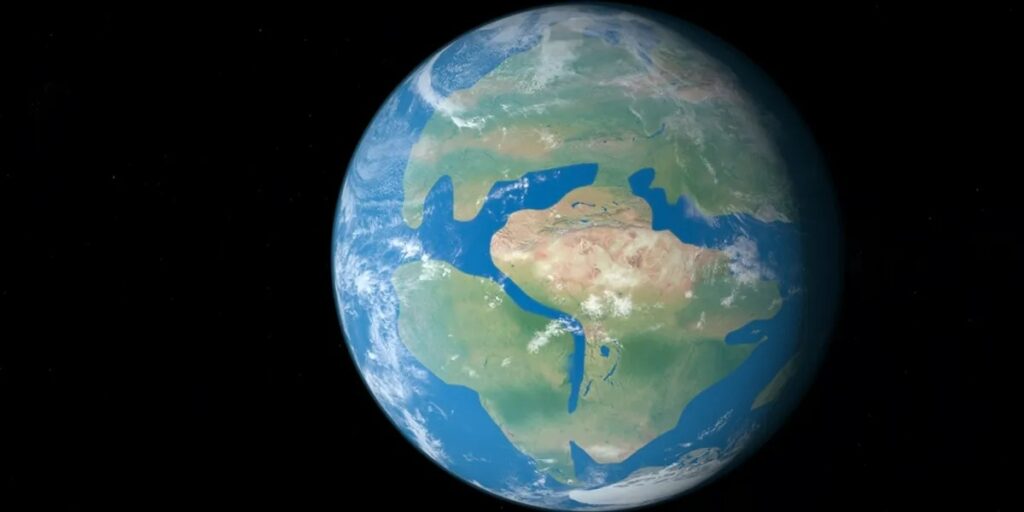
In the late 20th Century, the scientific community’s attention was captivated by a peculiar phenomenon hidden within the layers of ancient rocks scattered across the globe.
During the 1970s and 80s, geologists unearthed peculiar strata within ancient rock formations, dating back approximately 232-4 million years.
In the Eastern Alps, a team of researchers meticulously examined layers of siliclastic sedimentation interwoven with carbonate. Meanwhile, across the English landscape, the renowned geologist and forensic scientist Alastair Ruffell scrutinized gray rock formations nestled within the iconic red stones of the region. These discoveries, alongside numerous subsequent findings, all pointed to a singular conclusion: around 232 million years ago, the Earth emerged from a prolonged arid spell and was engulfed by incessant rainfall. Astonishingly, the deposition of gray sandstone and siliclastic sediment over an extensive period provided evidence that during the dawn of the dinosaur era, marked by a surge in their population and diversity, the planet experienced an unusually protracted wet phase spanning 1-2 million years.

Since this revelation, mounting evidence suggests that this moist epoch might have served as the catalyst for the proliferation and dominion of dinosaurs, and potentially other members of the modern terrestrial fauna.
This era, christened the Carnian pluvial event, or alternatively referred to as the Carnian crisis, has left its indelible mark on rock formations worldwide. The genesis of this extraordinary deluge appears to be linked to a dramatic surge in humidity, possibly triggered by a colossal volcanic eruption within the Wrangellia Large Igneous Province, spanning from south-central Alaska to the coast of British Columbia.
“The eruptions reached their zenith during the Carnian,” revealed Jacopo Dal Corso, a researcher involved in investigating the eruption’s aftermath. “Through my study of the eruptions’ geochemical signature some years ago, I discerned profound atmospheric repercussions globally. These eruptions were of such staggering magnitude that they unleashed copious amounts of greenhouse gases like carbon dioxide, precipitating spikes in global warming.”

Pangea, the supercontinent reigning over Earth during that epoch, was already predisposed to monsoonal patterns. These phenomena occur when moisture-laden air from the seas is propelled toward land, where it condenses and descends as torrential rains. With the seas attaining temperatures akin to hot soup during this period, as highlighted by paleoenvironments researcher Paul Wignall, the atmosphere above them would have been saturated with moisture, culminating in intensified monsoons and amplified precipitation on land.
Despite its pivotal role in shaping the planet’s evolutionary trajectory, the humid and damp phase proved to be inhospitable for life. A study published in the Journal of the Geological Society portrays this era as a time when “volcanic eruptions engendered acid rain and greenhouse gases, precipitating extinctions via abrupt warming, deforestation, and soil erosion on land, coupled with oceanic anoxia and acidification.”

Numerous species succumbed to the cataclysmic event. However, in its aftermath, certain organisms emerged as unequivocal victors.
“In the aftermath of widespread plant and herbivore extinctions on land, dinosaurs emerged as the primary beneficiaries during the recovery period, swiftly diversifying in terms of species, ecological influence, and geographical distribution, initially from South America and subsequently across all continents,” elucidated the research team in their publication.
“It might well be regarded as one of the most pivotal rapid events in the annals of life on Earth, pivotal not only in ushering in the ‘age of dinosaurs’ but also in laying the foundations for the emergence of the majority of key clades constituting the contemporary terrestrial tetrapod fauna, namely the lissamphibians, turtles, crocodiles, lizards, and mammals.”

Leave a Reply